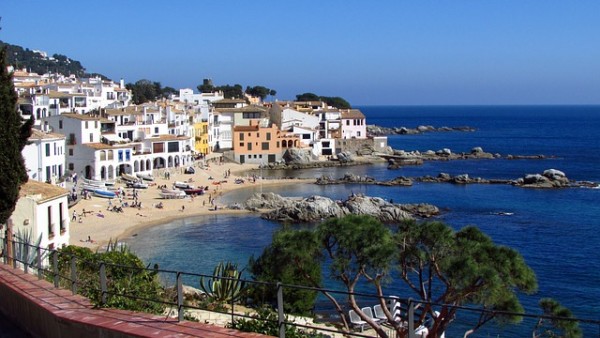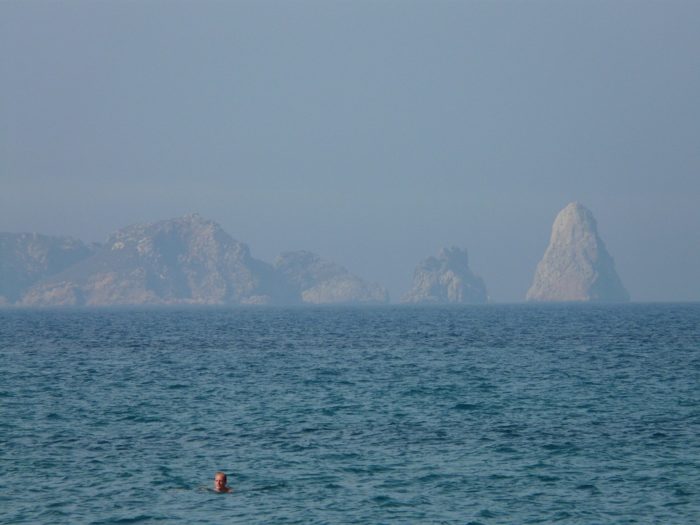The area of the central Costa Brava is within Baix Empordà, the southern part of the historical Empordà.

Calella de Palafrugell is just one of several fishing villages in the Baix Empordà
After the long sandy beach that extends down from Estartit down towards Sa Riera is some of the most spectacular coastline on the entire Costa Brava. In the area where the mountains around Begur drop into the sea you’ll find one picturesque fishing village after another. It’s simply stunning.
Further south there are plenty of sand beaches, but the coastline is in places spoilt by the number of holiday homes in the area. Some areas stand out though, even here. Just south of Platja d’Aro, S’Agarò dates from the 1920s and gets the balance right. Property prices are eye watering, some of the most expensive anywhere on the Costa Brava, but the houses are something to believe. You can get an idea of the properties by walking along the vertiginous coastal path between Sa Conca beach and Sant Pol.
Like the Alt Empordà, the comarca of Baix Empordà was created in 1936. At that time Catalonia was split into the comarcas that exist today. The capital is La Bisbal, located some 15 km inland, a town famous for its ceramics. There you’ll find many shops selling locally produced pottery throughout the town.
Much of Baix Emporà is mountainous and around a fifth covered in forest. Once predominantly oak, much has been replaced by pine at lower elevations. A lot of the oak is cork so it’s little surprise that one of the traditional industries here is producing wine bottle corks. Fishing is another, although the only remaining fishing ports are at Palamós and Sant Feliu de Guíxols. And of course there are the vinyards. Today part of the DO Empordà wine region lies in the comarca.
But whereas rice was widely cultivated now it is mainly limited to the area around Pals, and you’ll find the local rice in many shops. Much of the farmland is instead given over to growing apples and pears.
Natural parks
Baix Empordà has a number of protected areas both inland and on the coast. The Montrí massif, which borders with Alt Empordà, forms part of a natural park created in 2010. This area is covered in pine and low scrub.
Along the rocky coastline here, between l’Escala and Estartit, there are some really good diving sites. Both towns have a number of dive centres with twice or trice daily boats during summer. As well as the wetlands at the mouth of the river Ter to the south of Estartit, and an area of former military land in l’Escala, the park also includes the Medes Islands.

The Medes Islands off Estartit
The Medes lie a mile offshore from Estartit and diver numbers strictly controlled. In fact you’ll pay a surcharge to dive there in fact. The islands have been protected since 1983 and you’ll sometimes find police launches ensuring the dive boats and other craft operate within the law.
But the result is one of the best areas to dive in Spain with an abundance of fish and coral. Visibility is often extremely clear and on Meda Petita (shown on the map as Meda Xica) there is a large cavern through which you can dive. Here you can see huge groupers that are so tame they’ll follow you around on the dive. Elsewhere you may see conger eels, barracudas and numerous other marine life.
Back on dry land, a large part of the Gavarres mountain range is also protected as a place of natural interest. Plans to declare it a natural park were scuppered but there is still an area, primarily the southern slope, where the construction of housing is permanently forbidden.
History
Away from the coast you’ll notice many of the villages have a mediaeval influence. Two of the best examples are Pals and Peratallada, but notice how so many villages are centred around a church tower on a hill. Ullastret is another, but dates back to the 6th century BC when the area was settled by an Iberian tribe.
Towering above Torroella de Montgrí is a castle dating from the late 13th century. It’s a spectacular construction, built in the style of the Middle Eastern fortresses popular following the crusades. Designed so Barcelona could keep an eye on the Counts of Empordà, worked stopped in 1301 when Barcelona consolidated its power over the region.
The castle is still worth a visit though. It takes maybe an hour to reach from Torroella so you’re better off visiting off season. You get a great view too! Calonge is another town with a mediaeval castle, close to the resort of Sant Antoni de Calonge.
Notable people
Catalonia’s most important post-war author lived in Romanyà. Mercè Rodoreda’s best known work internationally is La plaça del diamant (1962, translated into English as The Time of the Doves). She lived in this tiny village in the Gavarres from 1972 until her death in 1983.
Internationally many stars have stayed at the five-star Hostal de la Gavina at S’Agarò since the Costa Brava first became popular with the Hollywood set. Frank Sinatra, Liz Taylor, Jean Cocteau, Sean Connery and Lady Gaga have all stayed at the luxury hotel over the years.
And Salvador Dalí owned property inland at Púbol, which he dedicated to his wife. Gala Dalí Castle is now a museum dedicated to the surrealist’s work, the third apex of the Dalí triangle. The other two are the theatre-museum at Figueres and his house at Portlligat near Cadaqués.

